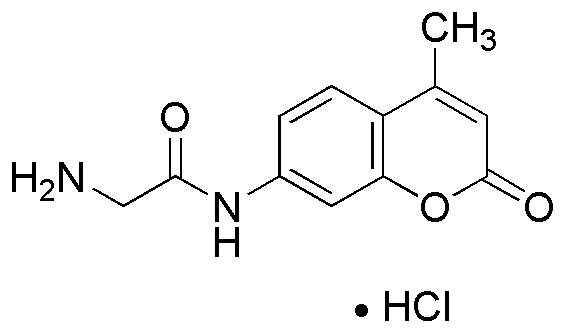Glycine 7-amido-4-methylcoumarin hydrochloride is widely utilized in research focused on:
- Fluorescent Probes: This compound serves as a fluorescent probe in biochemical assays, allowing researchers to study cellular processes and protein interactions with high sensitivity.
- Enzyme Activity Measurement: It is used to measure the activity of specific enzymes, particularly in the fields of biochemistry and molecular biology, providing insights into metabolic pathways.
- Drug Development: The compound plays a role in the development of new pharmaceuticals, particularly in targeting specific biological pathways, making it valuable in medicinal chemistry.
- Diagnostics: It can be incorporated into diagnostic tests to detect certain diseases, enhancing the accuracy and reliability of medical assessments.
- Research on Protein Folding: This chemical is instrumental in studying protein folding and stability, which is crucial for understanding various diseases related to protein misfolding.
General Information
Properties
Safety and Regulations
Applications
Glycine 7-amido-4-methylcoumarin hydrochloride is widely utilized in research focused on:
- Fluorescent Probes: This compound serves as a fluorescent probe in biochemical assays, allowing researchers to study cellular processes and protein interactions with high sensitivity.
- Enzyme Activity Measurement: It is used to measure the activity of specific enzymes, particularly in the fields of biochemistry and molecular biology, providing insights into metabolic pathways.
- Drug Development: The compound plays a role in the development of new pharmaceuticals, particularly in targeting specific biological pathways, making it valuable in medicinal chemistry.
- Diagnostics: It can be incorporated into diagnostic tests to detect certain diseases, enhancing the accuracy and reliability of medical assessments.
- Research on Protein Folding: This chemical is instrumental in studying protein folding and stability, which is crucial for understanding various diseases related to protein misfolding.
Documents
Safety Data Sheets (SDS)
The SDS provides comprehensive safety information on handling, storage, and disposal of the product.
Product Specification (PS)
The PS provides a comprehensive breakdown of the product’s properties, including chemical composition, physical state, purity, and storage requirements. It also details acceptable quality ranges and the product's intended applications.
Certificates of Analysis (COA)
Search for Certificates of Analysis (COA) by entering the products Lot Number. Lot and Batch Numbers can be found on a product’s label following the words ‘Lot’ or ‘Batch’.
*Catalog Number
*Lot Number
Certificates Of Origin (COO)
This COO confirms the country where the product was manufactured, and also details the materials and components used in it and whether it is derived from natural, synthetic, or other specific sources. This certificate may be required for customs, trade, and regulatory compliance.
*Catalog Number
*Lot Number
Safety Data Sheets (SDS)
The SDS provides comprehensive safety information on handling, storage, and disposal of the product.
DownloadProduct Specification (PS)
The PS provides a comprehensive breakdown of the product’s properties, including chemical composition, physical state, purity, and storage requirements. It also details acceptable quality ranges and the product's intended applications.
DownloadCertificates of Analysis (COA)
Search for Certificates of Analysis (COA) by entering the products Lot Number. Lot and Batch Numbers can be found on a product’s label following the words ‘Lot’ or ‘Batch’.
*Catalog Number
*Lot Number
Certificates Of Origin (COO)
This COO confirms the country where the product was manufactured, and also details the materials and components used in it and whether it is derived from natural, synthetic, or other specific sources. This certificate may be required for customs, trade, and regulatory compliance.


